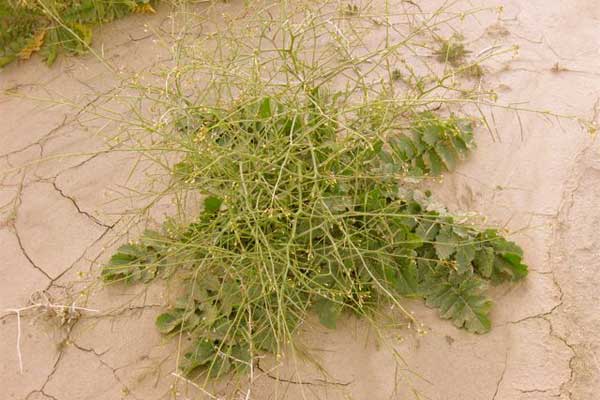
Tubb Canyon Desert Conservancy
Sahara Mustard
Identifying Sahara Mustard (Brassica tournefortii)
Information and photos below describe what Sahara Mustard looks like, as well as what looks like Sahara Mustard, but is not. To see more photos of Sahara Mustard from germination to maturity, visit the Sahara Mustard Life Cycle Slideshow.
The first photo was taken in a sandy wash among mustard-overwhelmed wildflower fields in North Borrego Valley. Note the large, dandelion-like leaves at the base of the airy, broad canopy of stems. In early development there will be tiny yellow flowers on the tips of each stem branch. Lower on the flower stalks, long, skinny seed pods develop that contain tiny, red poppy-like seeds. Flowers and seed pods are often on the plant at the same time. Even small Sahara Mustard plants can produce flowers and seed pods.

An isolated, young Sahara Mustard plant. To pull mustard, grab the main stem or stems as close to the ground as possible, pull with a steady pressure until the long, white, carrot-like taproot pops out of the ground. Wear gloves! Sahara Mustard stems are covered in tiny, prickly hairs that can irritate skin.
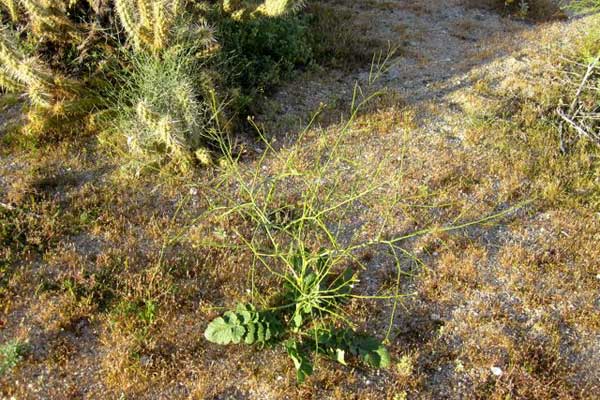
A larger, established Sahara Mustard plant. While larger plants produce more seed pods, even tiny mustard plants only a few inches tall can produce seed pods. Fast and early germination, especially in disturbed soils such as the edges of roadways, along with early seed pod production are survival traits of this plant. Sahara mustard pops up first, shades out germinating native plants, thereby eliminating its "competition." Sahara Mustard also goes to seed before most other plants.
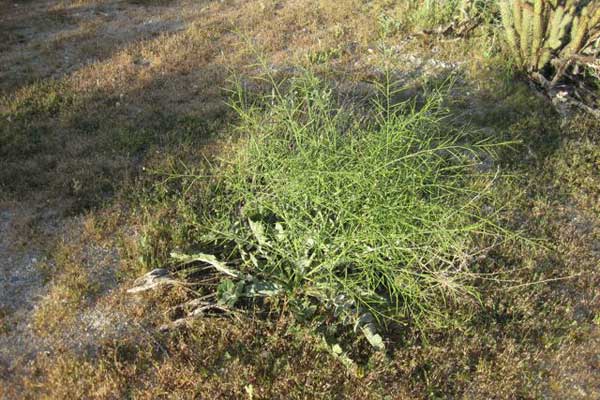
Sahara Mustard will eventually smother native plants, even cacti, and kill them by commandeering water with their long, carrot-like tap roots; by blocking sunlight to the victim plants; and perhaps by exuding chemicals that inhibit the growth of other plant species. In this photo, the dense cluster of mustard has been partially cleared away to reveal the barrel cactus and cholla that had been covered by the infestation. Patches of mustard this dense have been growing and reproducing on the site for a couple of years.
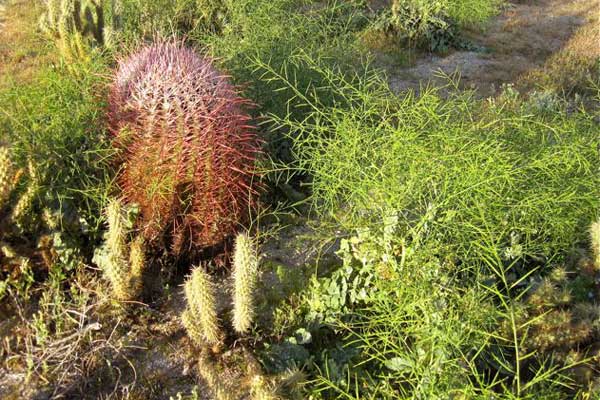
Sahara Mustard beginning to take over a phacelia and cholla patch.
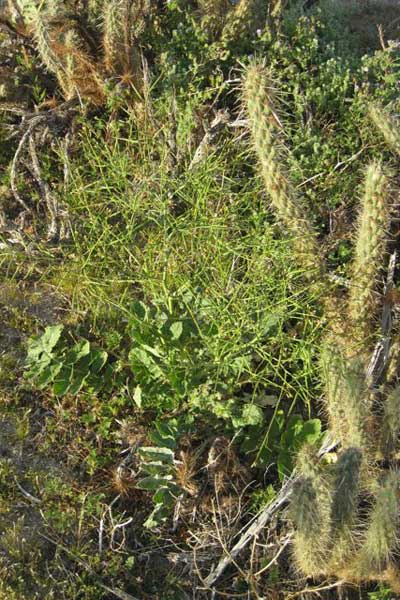
Close-up of premature, green Sahara Mustard seed pods or "beans." They look like stiff, skinny, 3-inch long green beans with slightly rounded indentations. Inside a ripe pod are round, poppy-seed size, bright red mustard seeds. One large mustard plant can produce 16,000 seeds! Just think of that every time you pull a plant and stuff it in trash bag! When dry and brown, the seed pods spring open and release their red seeds. There is a sticky coating on each seed that causes it to adhere to animal fur, shoe bottoms, clothing, and vehicle tires. Also, when the mature mustard plant dies and dries out, it become a type of tumbleweed. Wind easily breaks off the dried plant, which gets blown about, spewing seeds into new territory. That is another effective takeover strategy.
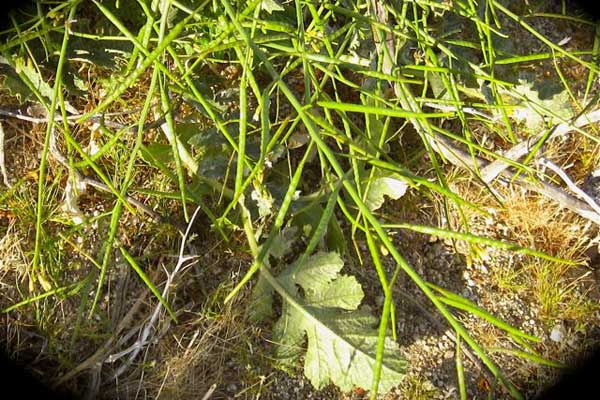
What looks like Sahara Mustard, but is not?
The plant below is NOT a Sahara Mustard, though it can look like Sahara Mustard at a glance. This is Desert Trumpet (Eriogonum inflatum), a native desert plant. Note the differences between mustard and this plant: Desert Trumpet has roundish basal leaves with a ripply pattern that does not in any way resemble the oversize, serrated dandelion-like leaves of Sahara Mustard. Also note the tall stems that lack seed pods and that are swollen at their base. Miniature desert poppy and a few other plants can also look like mustard at a glance; however, after studying the leaves and seed pods of Sahara Mustard, it becomes easy to identify the invader.
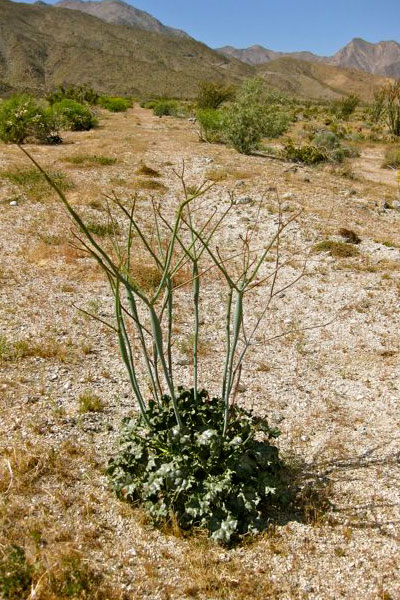
Close up of the swollen stem base on the Desert Trumpet. There are no alternating mustard seed "beans" on this plant's stems.
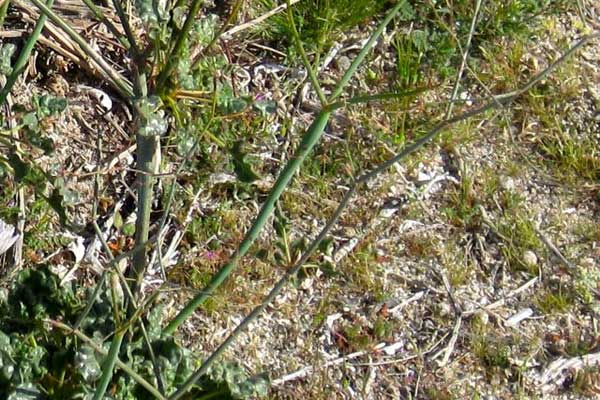
Another image of Desert Trumpet leaves and swollen stems.
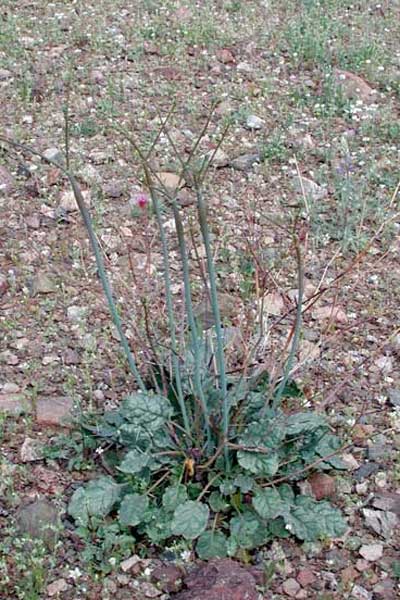
Photo courtesy of Desert Naturalist website:
For more Sahara Mustard identification photos, visit the Sahara Mustard Info.
